Travel and Tourism Marketing: Segmentation, Targeting, and Positioning
VerifiedAdded on 2023/01/13
|10
|2334
|44
Report
AI Summary
This report analyzes the marketing strategies employed by Contiki, a coach tour and tourism company. It begins with an introduction to Contiki, its operations, and its commitment to sustainable tourism. The main body delves into Contiki's market segmentation, including geographic, demographic, firmographic, behavioral, and psychographic segmentation, highlighting how Contiki targets specific age groups and interests. The report then examines Contiki's target market strategies, such as niche marketing and differentiated marketing, and discusses the importance of understanding customer needs. Furthermore, it explores the principles of positioning, including placement, product, price, and promotion, and how Contiki uses these elements to establish its brand in the market. The conclusion summarizes the key findings and suggests areas where Contiki can further refine its strategies to enhance its success in the competitive travel and tourism industry. The report is supported by references to relevant academic sources.
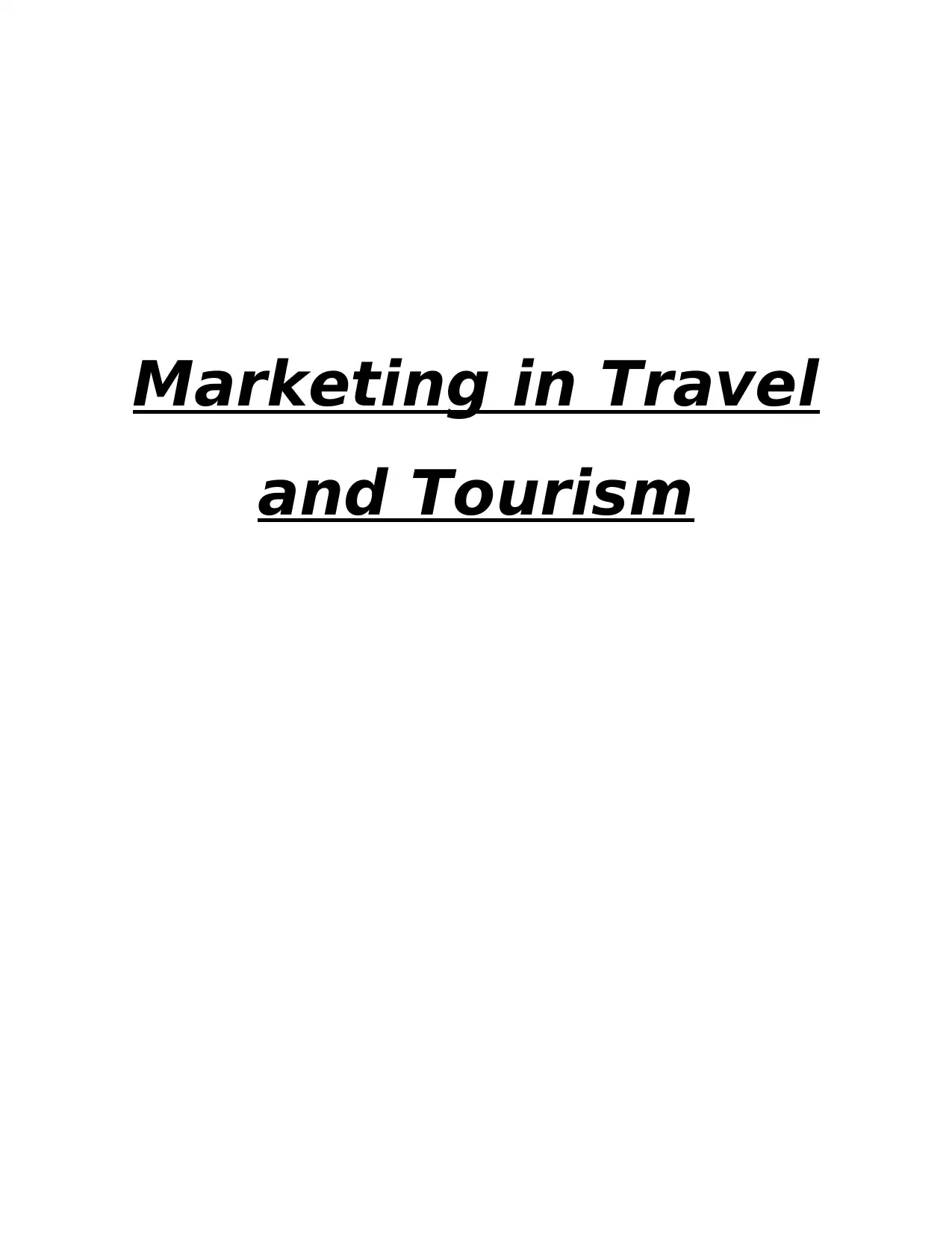
Marketing in Travel
and Tourism
and Tourism
Paraphrase This Document
Need a fresh take? Get an instant paraphrase of this document with our AI Paraphraser
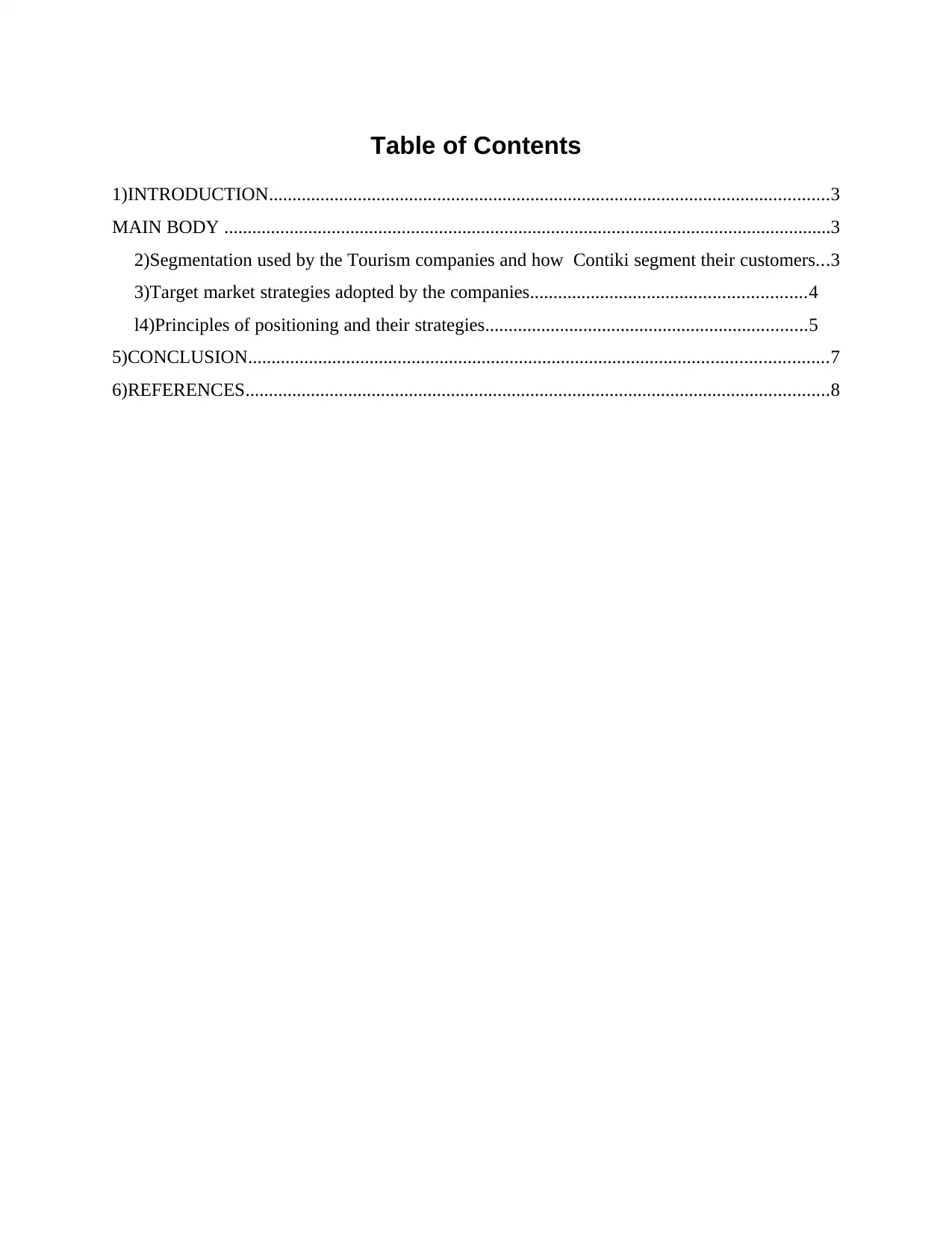
Table of Contents
1)INTRODUCTION........................................................................................................................3
MAIN BODY ..................................................................................................................................3
2)Segmentation used by the Tourism companies and how Contiki segment their customers...3
3)Target market strategies adopted by the companies...........................................................4
l4)Principles of positioning and their strategies.....................................................................5
5)CONCLUSION............................................................................................................................7
6)REFERENCES.............................................................................................................................8
1)INTRODUCTION........................................................................................................................3
MAIN BODY ..................................................................................................................................3
2)Segmentation used by the Tourism companies and how Contiki segment their customers...3
3)Target market strategies adopted by the companies...........................................................4
l4)Principles of positioning and their strategies.....................................................................5
5)CONCLUSION............................................................................................................................7
6)REFERENCES.............................................................................................................................8
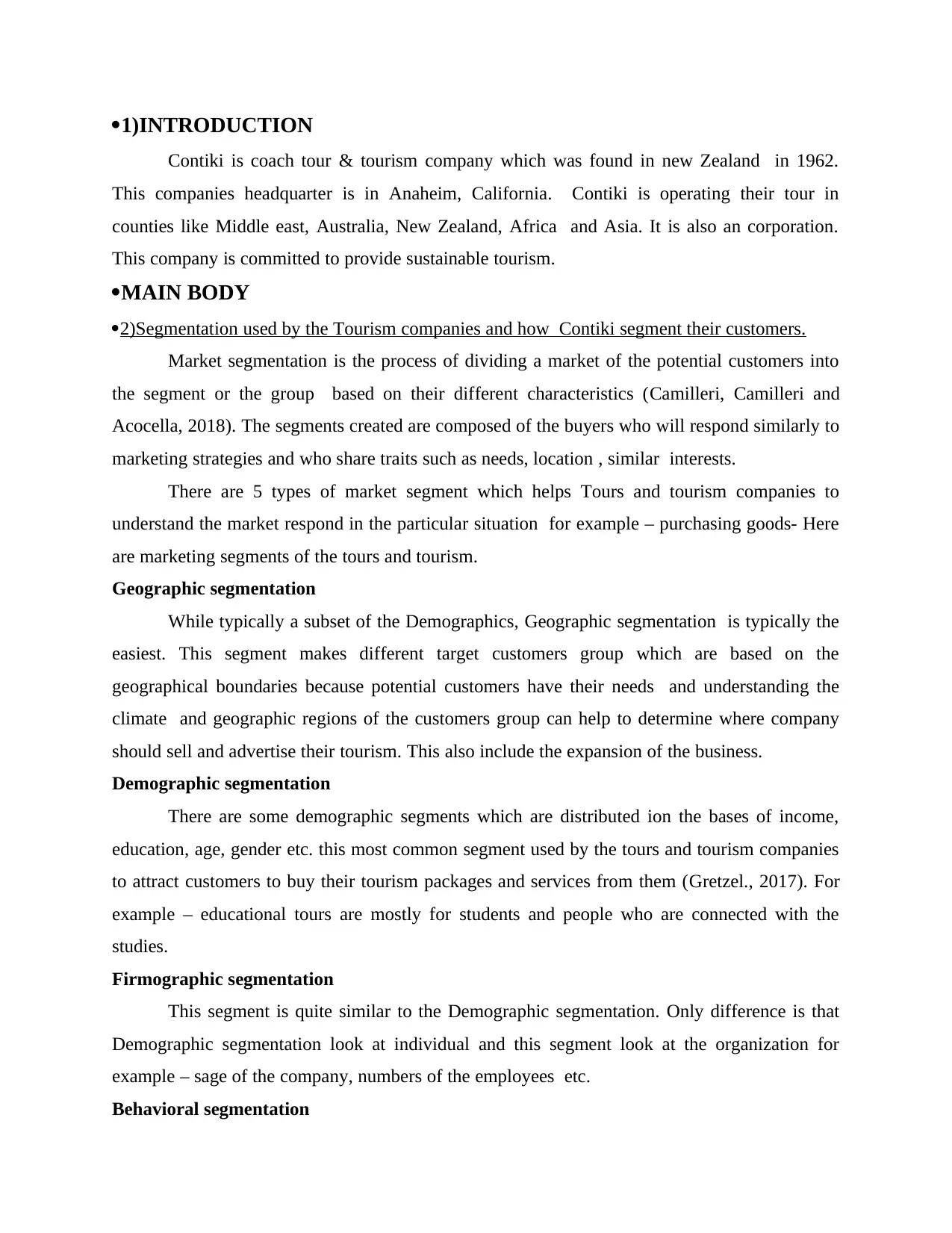
·1)INTRODUCTION
Contiki is coach tour & tourism company which was found in new Zealand in 1962.
This companies headquarter is in Anaheim, California. Contiki is operating their tour in
counties like Middle east, Australia, New Zealand, Africa and Asia. It is also an corporation.
This company is committed to provide sustainable tourism.
·MAIN BODY
·2)Segmentation used by the Tourism companies and how Contiki segment their customers.
Market segmentation is the process of dividing a market of the potential customers into
the segment or the group based on their different characteristics (Camilleri, Camilleri and
Acocella, 2018). The segments created are composed of the buyers who will respond similarly to
marketing strategies and who share traits such as needs, location , similar interests.
There are 5 types of market segment which helps Tours and tourism companies to
understand the market respond in the particular situation for example – purchasing goods- Here
are marketing segments of the tours and tourism.
Geographic segmentation
While typically a subset of the Demographics, Geographic segmentation is typically the
easiest. This segment makes different target customers group which are based on the
geographical boundaries because potential customers have their needs and understanding the
climate and geographic regions of the customers group can help to determine where company
should sell and advertise their tourism. This also include the expansion of the business.
Demographic segmentation
There are some demographic segments which are distributed ion the bases of income,
education, age, gender etc. this most common segment used by the tours and tourism companies
to attract customers to buy their tourism packages and services from them (Gretzel., 2017). For
example – educational tours are mostly for students and people who are connected with the
studies.
Firmographic segmentation
This segment is quite similar to the Demographic segmentation. Only difference is that
Demographic segmentation look at individual and this segment look at the organization for
example – sage of the company, numbers of the employees etc.
Behavioral segmentation
Contiki is coach tour & tourism company which was found in new Zealand in 1962.
This companies headquarter is in Anaheim, California. Contiki is operating their tour in
counties like Middle east, Australia, New Zealand, Africa and Asia. It is also an corporation.
This company is committed to provide sustainable tourism.
·MAIN BODY
·2)Segmentation used by the Tourism companies and how Contiki segment their customers.
Market segmentation is the process of dividing a market of the potential customers into
the segment or the group based on their different characteristics (Camilleri, Camilleri and
Acocella, 2018). The segments created are composed of the buyers who will respond similarly to
marketing strategies and who share traits such as needs, location , similar interests.
There are 5 types of market segment which helps Tours and tourism companies to
understand the market respond in the particular situation for example – purchasing goods- Here
are marketing segments of the tours and tourism.
Geographic segmentation
While typically a subset of the Demographics, Geographic segmentation is typically the
easiest. This segment makes different target customers group which are based on the
geographical boundaries because potential customers have their needs and understanding the
climate and geographic regions of the customers group can help to determine where company
should sell and advertise their tourism. This also include the expansion of the business.
Demographic segmentation
There are some demographic segments which are distributed ion the bases of income,
education, age, gender etc. this most common segment used by the tours and tourism companies
to attract customers to buy their tourism packages and services from them (Gretzel., 2017). For
example – educational tours are mostly for students and people who are connected with the
studies.
Firmographic segmentation
This segment is quite similar to the Demographic segmentation. Only difference is that
Demographic segmentation look at individual and this segment look at the organization for
example – sage of the company, numbers of the employees etc.
Behavioral segmentation
⊘ This is a preview!⊘
Do you want full access?
Subscribe today to unlock all pages.

Trusted by 1+ million students worldwide
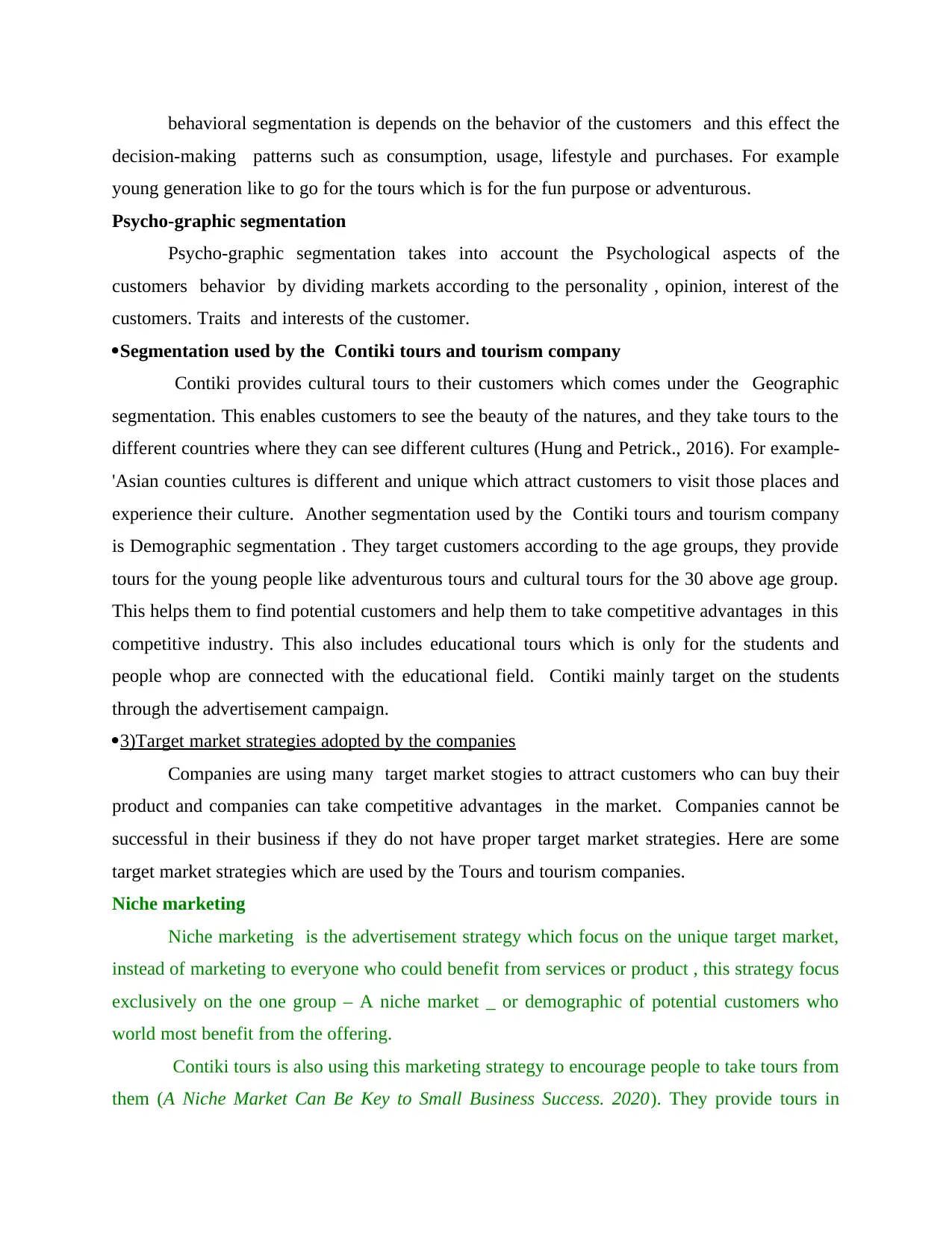
behavioral segmentation is depends on the behavior of the customers and this effect the
decision-making patterns such as consumption, usage, lifestyle and purchases. For example
young generation like to go for the tours which is for the fun purpose or adventurous.
Psycho-graphic segmentation
Psycho-graphic segmentation takes into account the Psychological aspects of the
customers behavior by dividing markets according to the personality , opinion, interest of the
customers. Traits and interests of the customer.
·Segmentation used by the Contiki tours and tourism company
Contiki provides cultural tours to their customers which comes under the Geographic
segmentation. This enables customers to see the beauty of the natures, and they take tours to the
different countries where they can see different cultures (Hung and Petrick., 2016). For example-
'Asian counties cultures is different and unique which attract customers to visit those places and
experience their culture. Another segmentation used by the Contiki tours and tourism company
is Demographic segmentation . They target customers according to the age groups, they provide
tours for the young people like adventurous tours and cultural tours for the 30 above age group.
This helps them to find potential customers and help them to take competitive advantages in this
competitive industry. This also includes educational tours which is only for the students and
people whop are connected with the educational field. Contiki mainly target on the students
through the advertisement campaign.
·3)Target market strategies adopted by the companies
Companies are using many target market stogies to attract customers who can buy their
product and companies can take competitive advantages in the market. Companies cannot be
successful in their business if they do not have proper target market strategies. Here are some
target market strategies which are used by the Tours and tourism companies.
Niche marketing
Niche marketing is the advertisement strategy which focus on the unique target market,
instead of marketing to everyone who could benefit from services or product , this strategy focus
exclusively on the one group – A niche market _ or demographic of potential customers who
world most benefit from the offering.
Contiki tours is also using this marketing strategy to encourage people to take tours from
them (A Niche Market Can Be Key to Small Business Success. 2020). They provide tours in
decision-making patterns such as consumption, usage, lifestyle and purchases. For example
young generation like to go for the tours which is for the fun purpose or adventurous.
Psycho-graphic segmentation
Psycho-graphic segmentation takes into account the Psychological aspects of the
customers behavior by dividing markets according to the personality , opinion, interest of the
customers. Traits and interests of the customer.
·Segmentation used by the Contiki tours and tourism company
Contiki provides cultural tours to their customers which comes under the Geographic
segmentation. This enables customers to see the beauty of the natures, and they take tours to the
different countries where they can see different cultures (Hung and Petrick., 2016). For example-
'Asian counties cultures is different and unique which attract customers to visit those places and
experience their culture. Another segmentation used by the Contiki tours and tourism company
is Demographic segmentation . They target customers according to the age groups, they provide
tours for the young people like adventurous tours and cultural tours for the 30 above age group.
This helps them to find potential customers and help them to take competitive advantages in this
competitive industry. This also includes educational tours which is only for the students and
people whop are connected with the educational field. Contiki mainly target on the students
through the advertisement campaign.
·3)Target market strategies adopted by the companies
Companies are using many target market stogies to attract customers who can buy their
product and companies can take competitive advantages in the market. Companies cannot be
successful in their business if they do not have proper target market strategies. Here are some
target market strategies which are used by the Tours and tourism companies.
Niche marketing
Niche marketing is the advertisement strategy which focus on the unique target market,
instead of marketing to everyone who could benefit from services or product , this strategy focus
exclusively on the one group – A niche market _ or demographic of potential customers who
world most benefit from the offering.
Contiki tours is also using this marketing strategy to encourage people to take tours from
them (A Niche Market Can Be Key to Small Business Success. 2020). They provide tours in
Paraphrase This Document
Need a fresh take? Get an instant paraphrase of this document with our AI Paraphraser
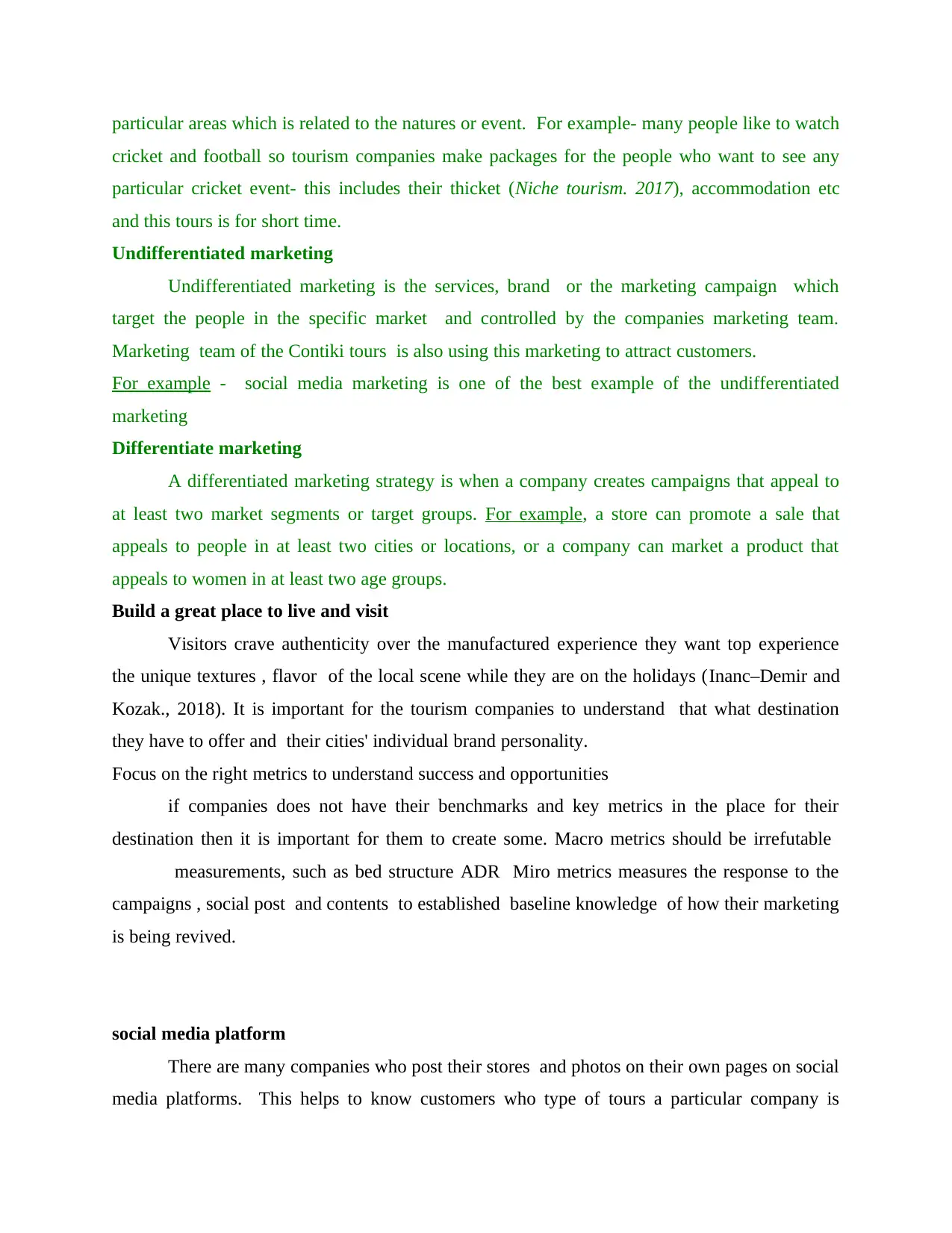
particular areas which is related to the natures or event. For example- many people like to watch
cricket and football so tourism companies make packages for the people who want to see any
particular cricket event- this includes their thicket (Niche tourism. 2017), accommodation etc
and this tours is for short time.
Undifferentiated marketing
Undifferentiated marketing is the services, brand or the marketing campaign which
target the people in the specific market and controlled by the companies marketing team.
Marketing team of the Contiki tours is also using this marketing to attract customers.
For example - social media marketing is one of the best example of the undifferentiated
marketing
Differentiate marketing
A differentiated marketing strategy is when a company creates campaigns that appeal to
at least two market segments or target groups. For example, a store can promote a sale that
appeals to people in at least two cities or locations, or a company can market a product that
appeals to women in at least two age groups.
Build a great place to live and visit
Visitors crave authenticity over the manufactured experience they want top experience
the unique textures , flavor of the local scene while they are on the holidays (Inanc–Demir and
Kozak., 2018). It is important for the tourism companies to understand that what destination
they have to offer and their cities' individual brand personality.
Focus on the right metrics to understand success and opportunities
if companies does not have their benchmarks and key metrics in the place for their
destination then it is important for them to create some. Macro metrics should be irrefutable
measurements, such as bed structure ADR Miro metrics measures the response to the
campaigns , social post and contents to established baseline knowledge of how their marketing
is being revived.
social media platform
There are many companies who post their stores and photos on their own pages on social
media platforms. This helps to know customers who type of tours a particular company is
cricket and football so tourism companies make packages for the people who want to see any
particular cricket event- this includes their thicket (Niche tourism. 2017), accommodation etc
and this tours is for short time.
Undifferentiated marketing
Undifferentiated marketing is the services, brand or the marketing campaign which
target the people in the specific market and controlled by the companies marketing team.
Marketing team of the Contiki tours is also using this marketing to attract customers.
For example - social media marketing is one of the best example of the undifferentiated
marketing
Differentiate marketing
A differentiated marketing strategy is when a company creates campaigns that appeal to
at least two market segments or target groups. For example, a store can promote a sale that
appeals to people in at least two cities or locations, or a company can market a product that
appeals to women in at least two age groups.
Build a great place to live and visit
Visitors crave authenticity over the manufactured experience they want top experience
the unique textures , flavor of the local scene while they are on the holidays (Inanc–Demir and
Kozak., 2018). It is important for the tourism companies to understand that what destination
they have to offer and their cities' individual brand personality.
Focus on the right metrics to understand success and opportunities
if companies does not have their benchmarks and key metrics in the place for their
destination then it is important for them to create some. Macro metrics should be irrefutable
measurements, such as bed structure ADR Miro metrics measures the response to the
campaigns , social post and contents to established baseline knowledge of how their marketing
is being revived.
social media platform
There are many companies who post their stores and photos on their own pages on social
media platforms. This helps to know customers who type of tours a particular company is
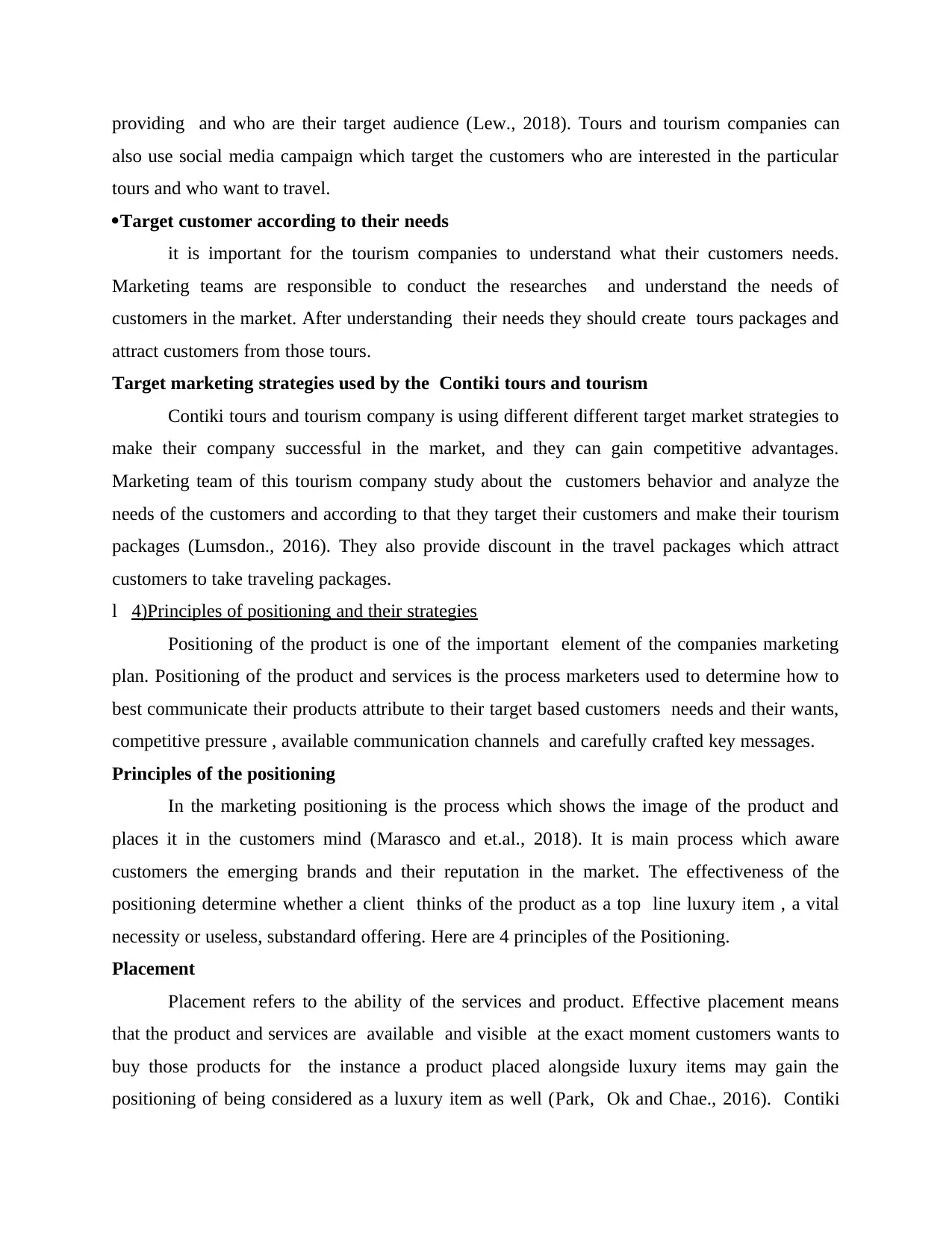
providing and who are their target audience (Lew., 2018). Tours and tourism companies can
also use social media campaign which target the customers who are interested in the particular
tours and who want to travel.
·Target customer according to their needs
it is important for the tourism companies to understand what their customers needs.
Marketing teams are responsible to conduct the researches and understand the needs of
customers in the market. After understanding their needs they should create tours packages and
attract customers from those tours.
Target marketing strategies used by the Contiki tours and tourism
Contiki tours and tourism company is using different different target market strategies to
make their company successful in the market, and they can gain competitive advantages.
Marketing team of this tourism company study about the customers behavior and analyze the
needs of the customers and according to that they target their customers and make their tourism
packages (Lumsdon., 2016). They also provide discount in the travel packages which attract
customers to take traveling packages.
l壱4)Principles of positioning and their strategies
Positioning of the product is one of the important element of the companies marketing
plan. Positioning of the product and services is the process marketers used to determine how to
best communicate their products attribute to their target based customers needs and their wants,
competitive pressure , available communication channels and carefully crafted key messages.
Principles of the positioning
In the marketing positioning is the process which shows the image of the product and
places it in the customers mind (Marasco and et.al., 2018). It is main process which aware
customers the emerging brands and their reputation in the market. The effectiveness of the
positioning determine whether a client thinks of the product as a top line luxury item , a vital
necessity or useless, substandard offering. Here are 4 principles of the Positioning.
Placement
Placement refers to the ability of the services and product. Effective placement means
that the product and services are available and visible at the exact moment customers wants to
buy those products for the instance a product placed alongside luxury items may gain the
positioning of being considered as a luxury item as well (Park, Ok and Chae., 2016). Contiki
also use social media campaign which target the customers who are interested in the particular
tours and who want to travel.
·Target customer according to their needs
it is important for the tourism companies to understand what their customers needs.
Marketing teams are responsible to conduct the researches and understand the needs of
customers in the market. After understanding their needs they should create tours packages and
attract customers from those tours.
Target marketing strategies used by the Contiki tours and tourism
Contiki tours and tourism company is using different different target market strategies to
make their company successful in the market, and they can gain competitive advantages.
Marketing team of this tourism company study about the customers behavior and analyze the
needs of the customers and according to that they target their customers and make their tourism
packages (Lumsdon., 2016). They also provide discount in the travel packages which attract
customers to take traveling packages.
l壱4)Principles of positioning and their strategies
Positioning of the product is one of the important element of the companies marketing
plan. Positioning of the product and services is the process marketers used to determine how to
best communicate their products attribute to their target based customers needs and their wants,
competitive pressure , available communication channels and carefully crafted key messages.
Principles of the positioning
In the marketing positioning is the process which shows the image of the product and
places it in the customers mind (Marasco and et.al., 2018). It is main process which aware
customers the emerging brands and their reputation in the market. The effectiveness of the
positioning determine whether a client thinks of the product as a top line luxury item , a vital
necessity or useless, substandard offering. Here are 4 principles of the Positioning.
Placement
Placement refers to the ability of the services and product. Effective placement means
that the product and services are available and visible at the exact moment customers wants to
buy those products for the instance a product placed alongside luxury items may gain the
positioning of being considered as a luxury item as well (Park, Ok and Chae., 2016). Contiki
⊘ This is a preview!⊘
Do you want full access?
Subscribe today to unlock all pages.

Trusted by 1+ million students worldwide
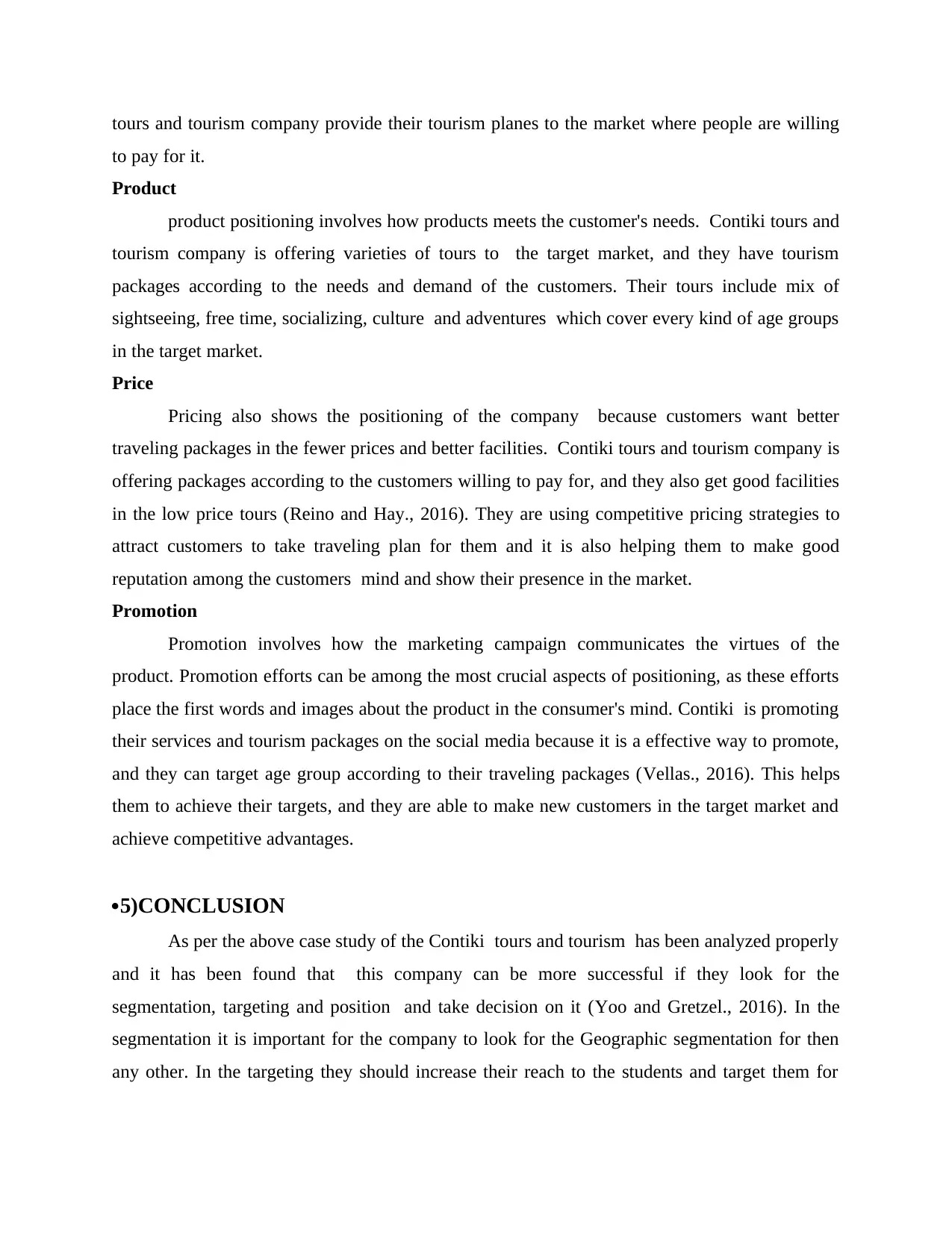
tours and tourism company provide their tourism planes to the market where people are willing
to pay for it.
Product
product positioning involves how products meets the customer's needs. Contiki tours and
tourism company is offering varieties of tours to the target market, and they have tourism
packages according to the needs and demand of the customers. Their tours include mix of
sightseeing, free time, socializing, culture and adventures which cover every kind of age groups
in the target market.
Price
Pricing also shows the positioning of the company because customers want better
traveling packages in the fewer prices and better facilities. Contiki tours and tourism company is
offering packages according to the customers willing to pay for, and they also get good facilities
in the low price tours (Reino and Hay., 2016). They are using competitive pricing strategies to
attract customers to take traveling plan for them and it is also helping them to make good
reputation among the customers mind and show their presence in the market.
Promotion
Promotion involves how the marketing campaign communicates the virtues of the
product. Promotion efforts can be among the most crucial aspects of positioning, as these efforts
place the first words and images about the product in the consumer's mind. Contiki is promoting
their services and tourism packages on the social media because it is a effective way to promote,
and they can target age group according to their traveling packages (Vellas., 2016). This helps
them to achieve their targets, and they are able to make new customers in the target market and
achieve competitive advantages.
·5)CONCLUSION
As per the above case study of the Contiki tours and tourism has been analyzed properly
and it has been found that this company can be more successful if they look for the
segmentation, targeting and position and take decision on it (Yoo and Gretzel., 2016). In the
segmentation it is important for the company to look for the Geographic segmentation for then
any other. In the targeting they should increase their reach to the students and target them for
to pay for it.
Product
product positioning involves how products meets the customer's needs. Contiki tours and
tourism company is offering varieties of tours to the target market, and they have tourism
packages according to the needs and demand of the customers. Their tours include mix of
sightseeing, free time, socializing, culture and adventures which cover every kind of age groups
in the target market.
Price
Pricing also shows the positioning of the company because customers want better
traveling packages in the fewer prices and better facilities. Contiki tours and tourism company is
offering packages according to the customers willing to pay for, and they also get good facilities
in the low price tours (Reino and Hay., 2016). They are using competitive pricing strategies to
attract customers to take traveling plan for them and it is also helping them to make good
reputation among the customers mind and show their presence in the market.
Promotion
Promotion involves how the marketing campaign communicates the virtues of the
product. Promotion efforts can be among the most crucial aspects of positioning, as these efforts
place the first words and images about the product in the consumer's mind. Contiki is promoting
their services and tourism packages on the social media because it is a effective way to promote,
and they can target age group according to their traveling packages (Vellas., 2016). This helps
them to achieve their targets, and they are able to make new customers in the target market and
achieve competitive advantages.
·5)CONCLUSION
As per the above case study of the Contiki tours and tourism has been analyzed properly
and it has been found that this company can be more successful if they look for the
segmentation, targeting and position and take decision on it (Yoo and Gretzel., 2016). In the
segmentation it is important for the company to look for the Geographic segmentation for then
any other. In the targeting they should increase their reach to the students and target them for
Paraphrase This Document
Need a fresh take? Get an instant paraphrase of this document with our AI Paraphraser

educational tours and position is important for them so pricing strategies can be helpful for them
to take competitive advantages.
to take competitive advantages.
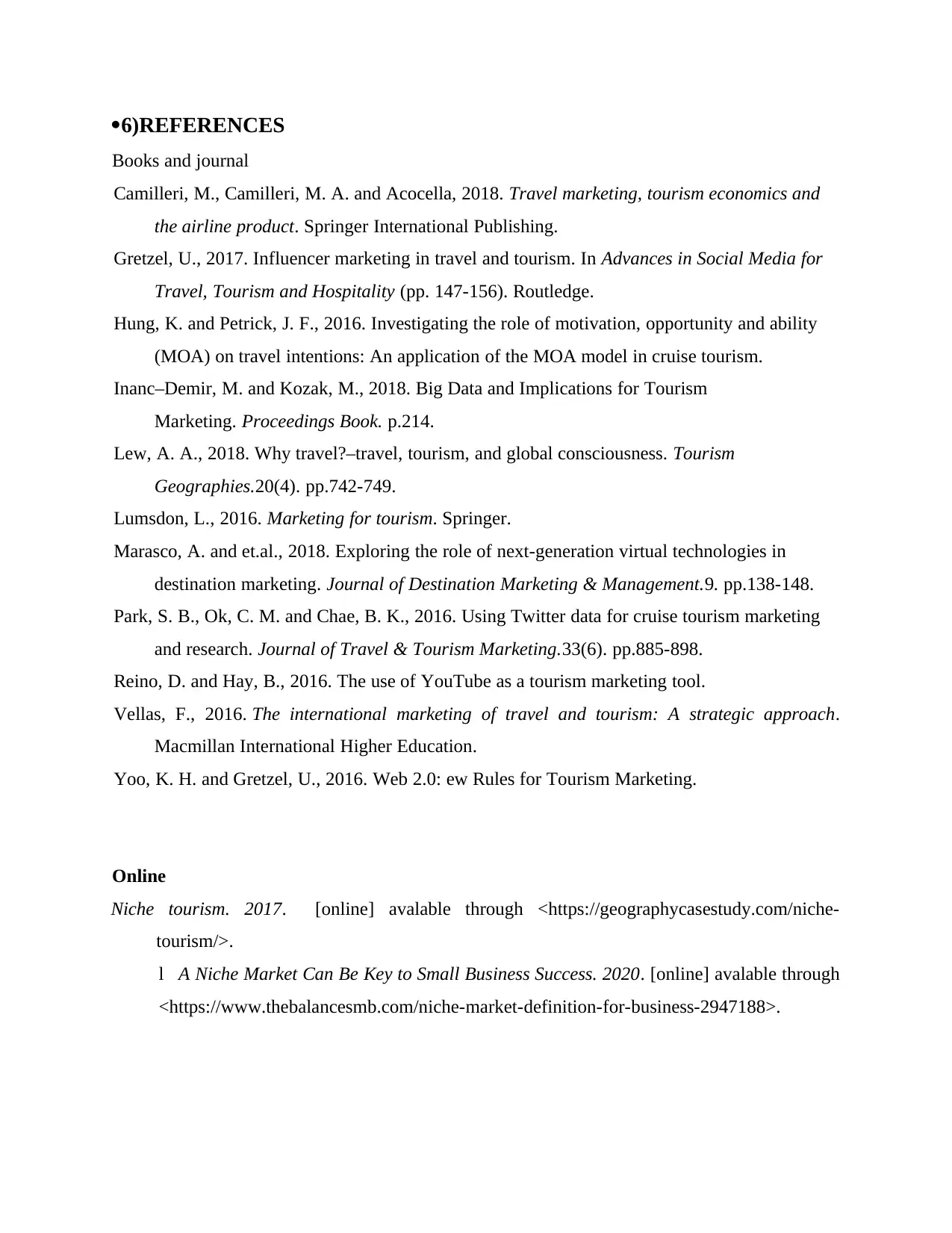
·6)REFERENCES
Books and journal
Camilleri, M., Camilleri, M. A. and Acocella, 2018. Travel marketing, tourism economics and
the airline product. Springer International Publishing.
Gretzel, U., 2017. Influencer marketing in travel and tourism. In Advances in Social Media for
Travel, Tourism and Hospitality (pp. 147-156). Routledge.
Hung, K. and Petrick, J. F., 2016. Investigating the role of motivation, opportunity and ability
(MOA) on travel intentions: An application of the MOA model in cruise tourism.
Inanc–Demir, M. and Kozak, M., 2018. Big Data and Implications for Tourism
Marketing. Proceedings Book. p.214.
Lew, A. A., 2018. Why travel?–travel, tourism, and global consciousness. Tourism
Geographies.20(4). pp.742-749.
Lumsdon, L., 2016. Marketing for tourism. Springer.
Marasco, A. and et.al., 2018. Exploring the role of next-generation virtual technologies in
destination marketing. Journal of Destination Marketing & Management.9. pp.138-148.
Park, S. B., Ok, C. M. and Chae, B. K., 2016. Using Twitter data for cruise tourism marketing
and research. Journal of Travel & Tourism Marketing.33(6). pp.885-898.
Reino, D. and Hay, B., 2016. The use of YouTube as a tourism marketing tool.
Vellas, F., 2016. The international marketing of travel and tourism: A strategic approach.
Macmillan International Higher Education.
Yoo, K. H. and Gretzel, U., 2016. Web 2.0: ew Rules for Tourism Marketing.
Online
Niche tourism. 2017. [online] avalable through <https://geographycasestudy.com/niche-
tourism/>.
l壱A Niche Market Can Be Key to Small Business Success. 2020. [online] avalable through
<https://www.thebalancesmb.com/niche-market-definition-for-business-2947188>.
Books and journal
Camilleri, M., Camilleri, M. A. and Acocella, 2018. Travel marketing, tourism economics and
the airline product. Springer International Publishing.
Gretzel, U., 2017. Influencer marketing in travel and tourism. In Advances in Social Media for
Travel, Tourism and Hospitality (pp. 147-156). Routledge.
Hung, K. and Petrick, J. F., 2016. Investigating the role of motivation, opportunity and ability
(MOA) on travel intentions: An application of the MOA model in cruise tourism.
Inanc–Demir, M. and Kozak, M., 2018. Big Data and Implications for Tourism
Marketing. Proceedings Book. p.214.
Lew, A. A., 2018. Why travel?–travel, tourism, and global consciousness. Tourism
Geographies.20(4). pp.742-749.
Lumsdon, L., 2016. Marketing for tourism. Springer.
Marasco, A. and et.al., 2018. Exploring the role of next-generation virtual technologies in
destination marketing. Journal of Destination Marketing & Management.9. pp.138-148.
Park, S. B., Ok, C. M. and Chae, B. K., 2016. Using Twitter data for cruise tourism marketing
and research. Journal of Travel & Tourism Marketing.33(6). pp.885-898.
Reino, D. and Hay, B., 2016. The use of YouTube as a tourism marketing tool.
Vellas, F., 2016. The international marketing of travel and tourism: A strategic approach.
Macmillan International Higher Education.
Yoo, K. H. and Gretzel, U., 2016. Web 2.0: ew Rules for Tourism Marketing.
Online
Niche tourism. 2017. [online] avalable through <https://geographycasestudy.com/niche-
tourism/>.
l壱A Niche Market Can Be Key to Small Business Success. 2020. [online] avalable through
<https://www.thebalancesmb.com/niche-market-definition-for-business-2947188>.
⊘ This is a preview!⊘
Do you want full access?
Subscribe today to unlock all pages.

Trusted by 1+ million students worldwide

1 out of 10
Related Documents
Your All-in-One AI-Powered Toolkit for Academic Success.
+13062052269
info@desklib.com
Available 24*7 on WhatsApp / Email
![[object Object]](/_next/static/media/star-bottom.7253800d.svg)
Unlock your academic potential
Copyright © 2020–2025 A2Z Services. All Rights Reserved. Developed and managed by ZUCOL.





